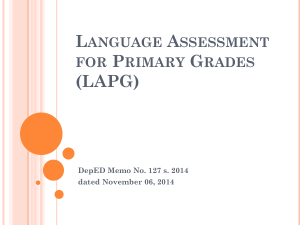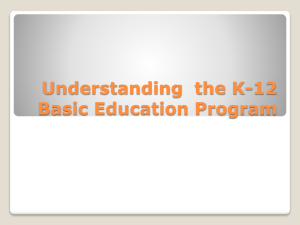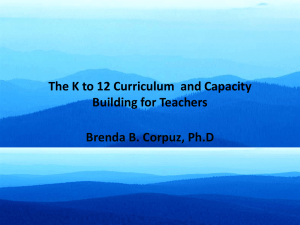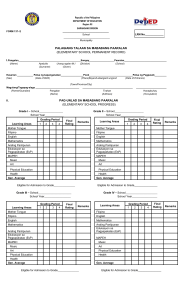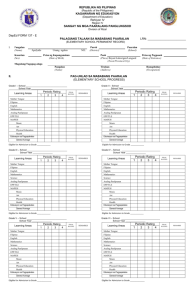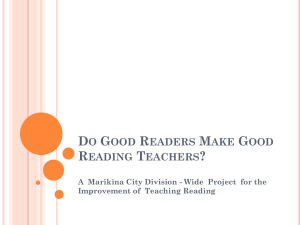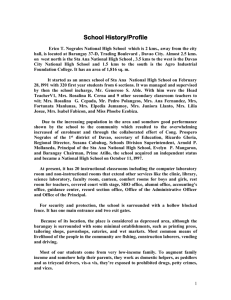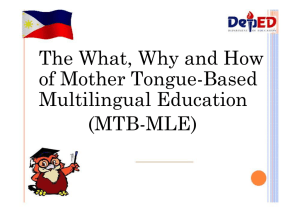Understanding the K-12 Basic Education Program
advertisement
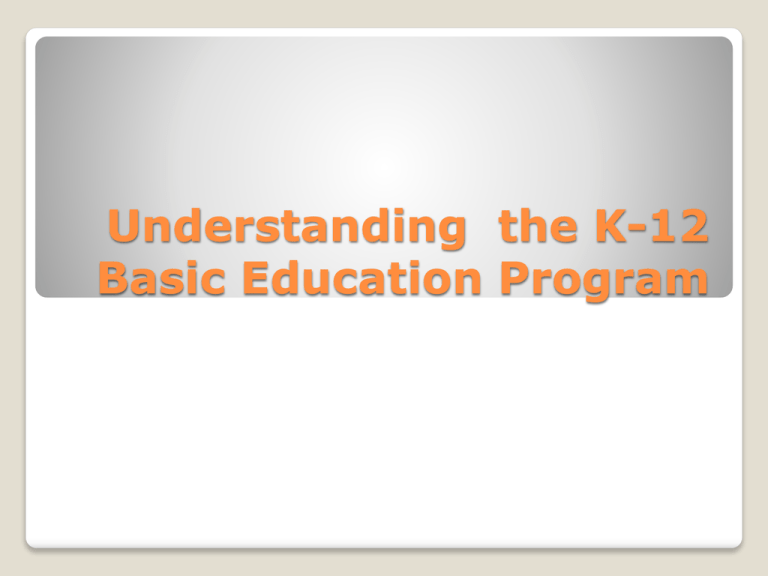
Understanding the K-12 Basic Education Program “Education is the key to the long-term problems of the country. If we fix basic education, we fix the long-term problems of the country. And if we fix the country’s problems, we will build a truly strong society. . .” -Pres. Benigno Simeon C. Aquino III 12-Year Basic Education Cycle Universal Kindergarten Madaris Education Technical-Vocational Education Every Child a Reader by Grade One Science and Math Proficiency GASTPE (Gov. Assistance to Student and Teachers to Private Education) 8. Medium of Instruction 9. Quality Textbooks 10. Covenant with LGUs 1. 2. 3. 4. 5. 6. 7. 10-Point Basic Education Agenda The Philippines is the only remaining country in Asia with a 10-year preuniversity program. The majority who do not go to college are too young to enter the labor force. Thus, they would either be unemployed or be vulnerable to exploitative labor practices. Those who may be interested to set up businesses cannot legally enter into contracts. Our graduates are being disadvantaged by their youth and inadequate preparation. . . The few, (only 23%) who would proceed to tertiary education, usually have to undergo remedial and high school level classes in colleges and universities. Those who graduate (17%) may not be recognized as professionals abroad. Our graduates are being disadvantaged by their youth and inadequate preparation. . . The Washington Accord prescribes 12 years of basic education as an entry to recognition of engineering professionals. The Bologna Accord requires 12 years of education for university admission and practice of profession in European countries. Our graduates are being disadvantaged by their youth and inadequate preparation. . . “We need to add two years to our basic education. Those who can afford pay up to fourteen years of schooling before university. Thus, their children are getting into the best universities and the best jobs after graduation. I want at least 12 years for our public school children to give them an even chance at succeeding.” -Pres. Benigno Simeon C. Aquino III 2 years 4 years 6 years 1 year • Senior High School • Junior High School • Elementary • Kindergarten K-6-4-2 System Enhancement of the basic education curriculum is the central focus of K to 12. The enhanced curriculum will offer areas of specialization or electives such as science and technology, arts, sports, journalism, tech-voc, foreign language, entreperneurship, and subjects for advanced placement. Key Features of K to 12 Vertical continuum and horizontal articulation of competencies Mother Tongue as a learning area and medium of instruction Spiral progression in Science and Math MAPEH (Music, Arts, Physical Education, and Health) begins in Grade 1 New Features of the K-12 Basic Education Curriculum Learning Areas for Grades 1 to 1o Grades 1 to 6 Grades 7 -10 Learning Areas Grade Levels Mother Tongue 1-3 English 1(2nd sem)-6 Filipino 1-6 Mathematics 1-6 Araling Panlipunan 1-6 Edukasyon sa Pagpapakatao 1-6 Science 3-6 MAPEH 1-6 EPP 4-5 TLE 6 SAMPLE CLASS PROGRAMMING Grade 1 Time Learning Areas 7:00-7:15 7:15-7:25 Pambansang Awit Homeroom 7:25-7:55 Edukasyon sa Pagpapakatao 30 7:55-8:45 Mother Tongue 50 8:45-9:15 Filipino 30 9:15-9:35 RECESS 9:35-10:15 Araling Panlipunan 40 10:15-10:45 English (Oral Fluency) 2nd Semester 30 10:45-11:35 Mathematics 50 1:00-1:30 Remediation, Reinforcement, Enrichment Activities or Optional Religious Instruction 1:30-2:10 MAPEH TOTAL Number of Minutes 40 240/270 Time Allotment NOMENCLATURE/ LEARNING AREA Grades 1 to 6 (No. of Minutes Daily) G1 G2 G3 G4 G5 G6 Grades 7 to 10 (Weekly) 1st Sem. 2nd Sem. Mother Tongue 50 50 50 50 - - - - Filipino 30 30 50 50 50 50 50 4 hrs English - 30 50 50 50 50 50 4 hrs Science - - - 50 50 50 50 4 hrs Mathematics 50 50 50 50 50 50 50 4 hrs Araling Panlipunan 40 40 40 40 40 40 40 3 hrs EPP/TLE - - - - 50 50 50 4 hrs MAPEH 40 40 40 40 40 40 40 4 hrs EsP 30 30 30 30 30 30 30 2 hrs 240 270 310 360 360 360 360 29 hrs Language Arts Total Grades 7-12 Core Curriculum and Career Paths Filipino learners, in order to be globally competitive, need to develop 21st century core skills( digital age literacy, inventive thinking, effective communication, and high productivity) and be functionally literate. Aside from the development of 21st century core skills, the extended high school program should be packaged for the preparation of students for career and higher education. This is because secondary education is designed primarily to provide the transition from school to work and from school to further learning. Premises The curriculum shall be designed to provide a blended career and college preparatory program. Putting the two on the same level and blending them will enhance the seamless relationship between career and higher education and give them equal social and economic value. Premises Grades 11-12 Grade 10 Grade 9 Grade 8 Grade 7 Academic Specialization: • Core Academic Areas (5) • Core Academic Areas(8) include TLE (choice of AgriFishery, Industrial Arts, HE or ICT) • Core Academic Areas (8) include TLE (choice of AgriFishery, Industrial Arts, HE or ICT) • Core Academic Areas (8) include TLE (choice of AgriFishery, Industrial Arts, HE or ICT) • Core Academic Areas (8) include TLE (choice of AgriFishery, Industrial Arts, HE or ICT) Engineering/ Journalism/Foreign Language Tech-Voc Specialization Sports/Arts Specialization MODEL 2 Junior/Senior HS Curriculum SY 20152016 SY 20142015 SY 20132014 SY 20122013 • Grade 10 • Grade 9 • Grade 8 • Grade 7 Implementation of Junior HS SY 20172018 SY 20162017 • Grade 12 • Grade 11 Implementation of Senior HS Learning Areas for Grades 11 and 12 Learning Areas Language* Grade 11 English Filipino Literature* Grade 12 English Filipino Philippine Literature (1st Sem) World Literature (2nd Sem) Mathematics* Math Math Science* Life Sciences Physical Science Social Sciences and Philosophy* Contemporary Issues Contemporary Issues (Global) Philosophy (Local) Career Pathways (Track-dependent) Entrepreneurship, TechVoc** Others (Arts, Sports, Security, Journalism, Science, etc) Entrepreneurship, TechVoc** Others (Arts, Sports, Security, Journalism, Science, etc) Others National Service Training Program National Service Training Program •Anchored on the College Readiness Standards of CHED •** Based on TESDA Training Regulations Senior High School benefits different students in different ways. Students who Students who Students who finish high complete 2 years complete college • Reduction in school then work of college or college years • Better income post-secondary offsets additional opportunities; • Reduction in years of higher income cost of schooling schooling streams with additional 2 • Higher • Cost due to years of “free” productivity delayed education (about 9% employment income premium) offset by higher • Higher college income streams completion rates A full 12 years of basic education will be required for entry into tertiary level education by SY 2018-2019. Completion of K to 12 education shall be compulsory for those who will go to college/university. Graduates of K to 12 Basic Education Program are envisaged to be better prepared for life as they are expected to possess sufficient mastery of 21st century core skills; be emotionally developed and competent to live a meaningful life; be socially aware, pro-active and involved in public and civic affairs; Vision be adequately prepared for the world of work or entrepreneurship or higher education; be legally employable; and be globally competitive. Vision An enhanced curriculum will decongest academic workload, giving students more time to master competencies and time for extra-curricular activities, thus, allowing for their more holistic development. Graduates will possess competencies and skills relevant to the job market. Graduates will be better prepared for higher education. Benefits of K to 12 to Individuals and Families Graduates will be able to earn higher wages and/or better prepared to start their own business. Studies in the Philippines have shown that an additional year of schooling increases earnings by 7.5%. Filipino graduates could be recognized abroad. Benefits of K to 12 to Individuals and Families K to 12 will contribute to economic growth. Several studies have shown that the improvements in the quality of education will increase GDP growth by as much as 2%. A better educated society provides a sound foundation for long-term socioeconomic development. Benefits of K to 12 to Society and the Economy Free for those in public schools Subsidized by the Government for those in the ESC program Who will cover the cost of the additional two years in high school? MORE POWER AND GOOD DAY EVERYONE!!!
